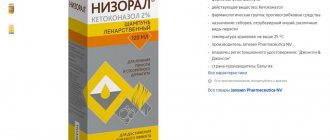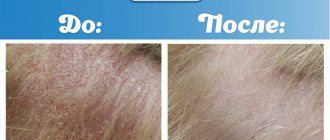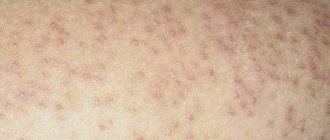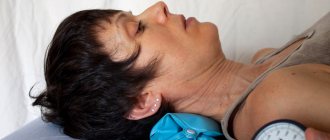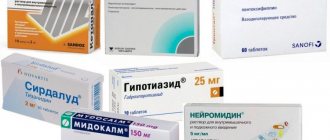Skin inflammation is caused by various diseases. One of them is seborrheic dermatitis, which occurs in children and adults. It is also called seborrheic eczema, which most often appears at a young age, but can also occur after 40, and even in newborns. Men are most susceptible to the disease. The causes of dermatitis are varied and varied, depending on the geographic location of a person.
Seborrheic dermatitis occurs on the face (eyebrows, eyelids, nose, forehead, etc.), on the scalp, in the chest and interscapular areas. The causative agent of the disease is the fungus malassezia furfur, which chooses places with a large accumulation of sebaceous glands.
What does dandruff look like?
White flakes, clearly visible on dark clothes, are nothing more than dandruff. It consists of scaly particles of keratinized skin, appears at the roots of the hair, and then easily falls off. Most often, the disease is provoked by the activity of the Malassezia fungus. It is present on the skin of every person, but only under certain conditions does it begin to multiply and cause dandruff.
When the fungus on the scalp becomes active, a person feels itchy. Depending on the reasons that caused the spontaneous reproduction of microorganisms and the characteristics of the sebaceous glands, seborrhea (this is what the disease accompanied by peeling is called) is divided into dry, oily, and mixed. It can also manifest itself in other forms.
Dry seborrhea
If there is a lack of activity in the sebaceous glands, dry seborrhea can occur. The reason is not only low sebum production, but also:
- stress, anxiety, psychological shocks;
- hereditary factors;
- hormonal disruptions (puberty or abnormalities in the functioning of the glands);
- use of incorrectly selected cosmetics, as well as cosmetic paints with ammonia;
- poor hygiene, excessively frequent hair washing and blow-drying;
- lack of vitamins (this affects the general health and functioning of the glands).
A deficiency of sebum contributes to the appearance of inflammatory processes on the scalp, which provoke the proliferation of Malassezia fungi. Symptoms of dry seborrhea:
- discoloration, dryness and brittleness of hair;
- formation of cracks in the epidermis;
- the appearance of large scales that quickly peel off.
If measures are not taken, dry seborrhea moves into the next stage. In addition to dandruff, a person is bothered by redness of the skin and seborrheic spots. Sometimes dry seborrhea is an advanced form of oily seborrhea, in other cases the problem arises on its own.
SKIN-CAP products
Modern clinical research [2] in the field of dermatology indicates the positive effect of products based on activated zinc pyrithione in the treatment of seborrhea - shampoo and aerosol SKIN-CAP.
The use of the products helped to eliminate the symptoms that bothered patients within 1-2 weeks of use [2].
The SKIN-CAP line includes medications in the form of cream, aerosol and shampoo; as well as skin care cosmetic product Skin-cap shower gel.
All forms of this drug are characterized by:
- High antimicrobial, antifungal and anti-inflammatory activity, due to which SKIN-CAP not only helps in relieving symptoms, but acts directly on the cause of these symptoms;
- High level of safety [4], thanks to which SKIN-CAP cream and aerosol are recommended for use by all categories of adults and children from 1 year of age [3];
- Wide choice of forms - the drug is available in 3 forms, which means that the doctor can easily select a flexible individual treatment regimen for a patient with any type of seborrhea in different parts of the body.
Oily seborrhea
If too much sebum is produced, this can also lead to dandruff. The fact is that the secretion does not contain enough antibacterial substances. Favorable conditions are created for an increase in fungal colonies. The active activity of Malassezia leads to detachment of the epidermis and the appearance of oily dandruff.
Symptoms of oily seborrhea:
- greasy hair;
- itching;
- The scales stick together and peel off very poorly.
Oily seborrhea is often accompanied by acne and furunculosis. The skin of the scalp becomes crusty; scratching during itching leads to bloody wounds. If adequate treatment is not carried out, hair will begin to fall out.
Seborrhea, associated with increased sebum production, occurs not only on the scalp. It also appears on the face, especially in the area of the nasolabial triangle, behind the ears and on the chin. On the face, the disease is characterized by enlarged pores and graying of the skin.
The most common cause of oily seborrhea is hormonal imbalances. The disease often plagues adolescents during puberty. Most often, young men suffer, because it is male hormones that provoke the activity of the sebaceous glands.
Normally, seborrhea is temporary; by the age of 25, it goes away in most people. In 10% of cases the disease becomes chronic.
Another common cause of oily seborrhea is genetics.
Also, the impetus for the disease can be:
- frequent stress;
- deviations in the functioning of the nervous system;
- taking hormones;
- problems with the gastrointestinal tract;
- diseases of the genitourinary system.
Diagnostics
Oily seborrhea is distinguished by characteristic symptoms. Despite this, the process of diagnosing seborrhea includes a set of measures.
First, the doctor gets acquainted with the patient's medical history. This allows you to determine what led to seborrhea. After this, he collects and analyzes his life history. This makes it possible to find out against what factors the pathology of the epidermis of the head developed. Then a thorough examination of the affected segments of the head is carried out and a complete clinical picture of the course of seborrhea is compiled.
Also, before treatment, comprehensive instrumental diagnostics are carried out. The doctor examines both skin and hair.
The main methods of examining the head and hair include:
- Skin scrapings and microscopic examination of hair.
- X-ray of the abdominal cavity.
- Ultrasound of the thyroid gland.
- CT and MRI.
Patients also undergo laboratory diagnostics. It includes a general and biochemical blood test, as well as hormonal tests. If necessary, a gynecologist and andrologist, a neurologist, an endocrinologist and other specialized doctors are involved in the examination, diagnosis and further treatment.
Mixed seborrhea
Mixed seborrhea has characteristics of dry and oily varieties. In particular, patients note that the skin on the face in the middle part is oily, and on the cheeks it is dry. Especially a lot of fat is released in the areas of the crown, chin, forehead, and nose. In other places the fat content is moderate or insufficient.
Doctors also note that a person may be bothered by dry dandruff and oily skin on the face.
Symptoms of mixed seborrhea:
- inflammatory process on the cheeks, scalp, chin, forehead, chest, nose;
- in the area of inflammation, the skin becomes rough;
- redness, itching;
- increased secretion of sebum on the forehead, but decreased secretion in other areas of the face;
- peeling in the area of increased activity of fat-secreting glands, yellowish or gray scales;
- peeling of dry areas of skin.
All the factors listed above as causes of other types of the disease can provoke mixed seborrhea. Most often the problem is associated with hormonal changes or disruptions. Heredity plays an important role. Stress and anxiety can also contribute to the growth of fungi.
Treatment
If you do not show vigilance in a timely manner and allow the development of oily dandruff, it will take a long time to get rid of it in the future. Treatment and hair restoration after seborrheic dermatitis is especially effective if you take an integrated approach.
Of course, the prescription of procedures and medications is a medical diocese; one’s own knowledge from the field of medicine, especially in advanced cases, is inappropriate. But you can always use suitable means for prevention, especially when it comes to folk methods of combating oily seborrhea.
Drug treatment
The composition of medicinal preparations includes components that regulate the functioning of the sebaceous glands and have an antifungal effect. They stop inflammation, relieve skin from itching, and eliminate oily dandruff on hair. Special medicated shampoos are suitable for therapeutic purposes:
- Nizoral 2% - available in volumes of 60 milliliters (price - from 700 rubles) and 120 milliliters (costs approximately 850 rubles). A small bottle is enough for 1.5–2 months of treatment and prevention of oily seborrhea of the head. The hair product reduces inflammation, relieves itching and dandruff, and fights fungus;
- Sebozol is a shampoo in bags of 5 milliliters (a set of 5 pieces costs about 150 rubles) and in bottles of 100, 200 milliliters (350–470 rubles). Recommended for hair restoration after seborrhea, treatment and prevention of dandruff. Has an antifungal effect;
- Sulsena - there is shampoo paste (40 and 75 milliliters, cost 80-120 rubles), peeling shampoo (150 milliliters will cost 300 rubles) and regular shampoo for hair covered with dandruff (volume - 150 milliliters, price - about 250 rubles ). The drugs normalize the functioning of the sebaceous glands, reduce the tendency of cells to exfoliate, and suppress pathogenic microflora.
Attention! You can also find Sulsen shampoos with nettle or Sulsen Forte on sale. They have a different manufacturer, and the price starts from 200 rubles.
A line of drugs against seborrhea is offered by the Ducray brand. Products from the Squanorm series are intended specifically for the treatment of dandruff (separately for dry and oily). Ducray Squanorm improves the activity of the sebaceous glands and permanently eliminates white flakes.
For oily scalp seborrhea, the following are recommended:
- shampoo marked Grasses (Sèches products are suitable for dry dandruff) - there are bottles of 125 milliliters (from 700 rubles) and 200 milliliters (from 840 rubles). Contains palm extract;
- Ducray Squanorm Lotion is a universal lotion with zinc sulfate, citric acid and other ingredients that accelerates skin regeneration, disinfects and softens it, and eliminates itching. The product does not need to be washed off from the hair. Suitable for daily use. Price - about 900 rubles for 200 milliliters;
- Ducray Squanorm set for oily scalp - the same products, but in combination: shampoo (200 milliliters) and a mini bottle of lotion (30 milliliters) will cost from 800 rubles.
There are other medicinal shampoos for seborrhea: Fitoval, Perhotal. Many of them contain ketoconazole, an effective antifungal component, and are used not constantly, but according to a certain scheme, in courses. According to the principle of action, special preparations differ from cosmetic products for hair (Head & Shoulders, Clear Vita), which are more suitable for preventing the problem and are suitable for long-term use.
In addition to shampoos, you can treat oily seborrhea of the head with ointments :
- salicylic acid - to destroy the fungus that causes peeling of the skin. Costs from 20 rubles;
- zinc - for healing, drying, achieving an antiseptic effect. Price - from 15 rubles. To avoid drying out your hair and skin, you need to combine this ointment with essential or vegetable oils;
- sulfur - in advanced cases. The cost is approximately 35 rubles.
To eliminate the unpleasant symptoms of seborrhea, boric and salicylic acid and other drugs are used.
If the source of problems with hair and skin is problems with internal organs or nervous tension, the appropriate medications will help: Pancreatin (to improve digestion, costs from 20 rubles), Novopassit (to provide a sedative effect, the price depends on the form of release), Roaccutane (for severe forms acne, cost from 2 thousand rubles) and many others. But only a doctor should prescribe any medications!
Traditional methods
Home recipes are not a panacea when it comes to pathology that manifests itself in the form of oily seborrhea of the scalp. However, they are effective in eliminating dandruff and giving hair a well-groomed appearance. Such methods are best used as an addition to the main therapy, as well as for the prevention of the disease. Masks, rinses, lotions prepared according to folk recipes regulate the functioning of the sebaceous glands, relieve inflammation, and soothe sensitive skin.
Popular ingredients in the fight against white flakes and increased oiliness of hair are: lemon, calendula, onion peels, fresh berries and fruits.
Lemon
Prepare a citrus decoction from it:
- cut the peel removed from 4 fruits into pieces;
- fill it with a liter of water and place it on the stove;
- Bringing to a boil, boil the zest for 25 minutes over low heat;
- filter;
- use as a mouthwash once a week. During the procedure, also massage your scalp.
You can prepare a simple mask for oily hair:
- squeeze out fresh citrus juice;
- dilute with water in a 1:1 ratio;
- rub into scalp;
- after 10–15 minutes, rinse it out of your hair using shampoo;
- use 1-2 times a week for a month.
Another recipe for a mask for oily seborrhea of the head:
- take natural lemon juice, mayonnaise, honey, aloe juice and castor oil in equal parts;
- mix and add 1-2 cloves of garlic;
- rub into the roots of your hair, warm your head;
- after 30–45 minutes, rinse with shampoo.
Attention! In addition to getting rid of oily dandruff, such a mask can improve hair growth.
Calendula
Buy a pack of dried flowers at the pharmacy and prepare a decoction:
- pour a tablespoon of the mixture into 2 cups of boiling water;
- leave to infuse;
- Rub the lukewarm liquid into the skin;
- cover your hair with plastic, then with a towel;
- After 40 minutes, remove the insulation, but do not rinse off the product. Use this recipe against oily seborrhea on the scalp to eliminate white flakes and strengthen your hair.
An effective remedy for oily dandruff is tincture of marigold (another name for calendula) in alcohol. You can also buy it at the pharmacy. A mask with this component improves the activity of the sebaceous glands and suppresses the proliferation of fungal infections. The drug is used in two ways:
- rub in pure form into the skin half an hour before washing your hair, be sure to insulate your hair;
- combine with burdock or castor oil, measuring 10 teaspoons of tincture and 1 teaspoon of oily base. Distribute over the head 2 hours before going to the shower.
Burdock
For oily seborrhea of the head, prepare a decoction of the roots of a medicinal plant to rub into the skin and rinse the hair:
- pour 2 tablespoons of crushed raw materials with a glass of boiling water;
- simmer over low heat for 15 minutes;
- cool and use as intended.
You can rub this decoction into the roots every other day.
Onion
A well-known remedy against hair loss, as well as oily dandruff. You can mix the plant juice and vodka in equal parts, and then rub the mixture into the skin half an hour before hygiene procedures. To prepare the rinse, steam 50 grams of husks with a liter of boiling water.
After cooling, filter. Apply after every hair wash. After regular use of the decoction, blondes will notice that their curls have acquired a golden hue.
Also, to get rid of oily seborrhea of the scalp, prepare a mask:
- combine the juice of one onion with a couple of tablespoons of dry mustard;
- diluted with hot water to obtain the consistency of thick sour cream;
- add chicken yolk, 1 tablespoon each of honey and aloe extract, 1 ampoule of vitamins B1 and B6;
- Apply to hair roots, warm and leave for an hour.
Fresh vegetables, fruits, berries
If you have dandruff and oily hair, apply the juice/gruel of cucumber, pumpkin or zucchini to your hair. Strawberries, currants, and apple peels are also suitable. Keep the mask on your head for 30 minutes, repeat twice a week.
Effective remedies for oily dandruff - nettle, chamomile, propolis extract, walnut leaves, soda, sea salt and other ingredients. Prepare herbal infusions, soda rinses, or rub salt grains into dry scalp to give your hair a well-groomed look.
Alternative Methods
- Vitamin therapy . If the body lacks nutrients, the doctor may prescribe treatment with vitamins. For oily seborrhea of the head, components of group B are needed, as well as A, E, D. They are found in certain foods (carrots, citrus fruits, fish, vegetable oils, eggs and others). However, it is not always possible to obtain from food the necessary amount of vitamins that would satisfy the body’s daily needs. Therefore, in advanced cases, it is necessary to compensate for the deficiency with medicinal methods. But an excess of nutrients (hypervitaminosis) is also bad. To prevent this, consult your doctor before going to the pharmacy.
- Mesotherapy . A method for those who are not afraid of injections. Thanks to them, hair and skin will become healthier and get rid of oiliness. The composition of the injections includes vitamins, microelements, amino acids, which directly affect the source of the problem. This is also the main drawback of the procedure: if the cause of oily seborrhea of the head lies in a hormonal disorder, nervous strain or pathology of internal organs, mesotherapy will not be effective.
- MIL therapy . It involves exposing the affected areas to magnetic and laser beams. It has an anti-inflammatory effect, improves tissue microcirculation, which has a positive effect on the condition of the skin and hair.
- Ozone therapy . Has bactericidal and drying properties. Normalizes metabolic processes, improves hair structure and root nutrition.
- Physiotherapy . In addition to meso-, MIL- and ozone therapy, it includes other procedures that can cure oily seborrhea of the head. This is darsonvalization (improving blood flow using a special device), cryomassage (exposure to cold), ultraviolet irradiation and others.
Attention! Any alternative method used against oily dandruff requires courses of treatment.
Tubular seborrhea
This is a special type of seborrhea, the main symptom of which is the formation of scales not on the scalp, but on the hair. This is explained by the fact that the active reproduction of the Malassezia fungus began precisely on the hairline. Dandruff looks like small tubes, which are sometimes confused with nits.
Tubular seborrhea is also characterized by severe itching and redness. Most often it occurs in adolescence, when hormonal levels are actively restructured.
Also, the causes of tubular dandruff can be:
- lack of vitamins;
- metabolic disease;
- improper or insufficient hygiene;
- improper or poor nutrition, diets;
- physical and emotional stress;
- skin diseases;
- chronic illnesses, hepatitis, HIV and other diseases that reduce immunity.
Seborrheic dermatitis
When listing the types of dandruff, one cannot fail to mention seborrheic dermatitis. This is a general term for diseases that are associated with the active proliferation of fungi, the formation of crusts, redness, itching and peeling.
Seborrheic dermatitis can occur with infectious diseases such as lichen, or non-infectious diseases - psoriasis, neurodermatitis. Symptoms appear on the skin in areas with impaired sebum secretion.
The fungus produces lipotic enzymes that break down fatty acids. When there are too many enzymes, an inflammatory reaction occurs on the skin. Outwardly, at first it looks like peeling. Scratching leads to the formation of bleeding wounds.
The symptoms of seborrheic dermatitis are similar to dandruff. However, we are talking about it only if more than 83% of the microflora of the scalp consists of pathogenic fungi. For dandruff, this figure is 74%. Thus, dandruff is the first stage of seborrheic dermatitis. If left untreated, it will lead to serious consequences.
Forms, features of the disease
Dandruff and unattractive hair appearance are just a partial manifestation of the oily type of seborrhea. The form of the disease largely influences how the hair and skin look. Experts highlight:
- Thick seborrhea. In this case, the dermis becomes dense and less elastic. The complexion and skin acquire a gray-brown tint. Abundantly secreted sebum changes its composition. It becomes thicker and clogs the sebaceous ducts, which leads to inflammation and blackheads. If you press on enlarged pores, you may notice a thick, viscous discharge. In advanced cases, atheromas (cysts on the skin) form, which require surgical intervention. The doctor opens them and pumps out the contents. In its thick form, oily hair becomes rough and hard to the touch.
- Liquid seborrhea. The skin on the head resembles the peel of an orange: it literally shines, and sebaceous formations stand out from the enlarged pores. Hair has an unhealthy shine, as if it has been oiled. They stick together, and in severe forms of seborrheic dermatitis they begin to actively fall out. My head itches all the time. Dandruff has a yellowish tint to the fat.
Psoriasis and dandruff
Dandruff on the head appears not only due to the activity of the sebaceous glands and fungi. Sometimes scales on the hair occur with psoriasis. This is a common disease associated with heredity and the body's immune system. The disease is chronic, its therapy is designed to reduce symptoms.
Signs of psoriasis:
- the appearance of pink or red spots (occur not only on the head, but also on the arms, legs, and other parts of the body);
- gray scales on plaques;
- itching, sometimes pain.
An outbreak of this autoimmune disease can easily be confused with seborrhea. It is important to see a doctor on time, because the treatment of these ailments is very different.
Psoriasis appears between the ages of 15 and 35 years. Outbreaks of the disease can be caused by:
- poor nutrition;
- cold or dry air;
- stress.
The causative agent is not fungi, but the person’s own immunity, which attacks healthy cells, which causes active growth of the epidermis.
Therapy requires close supervision by a dermatologist. Both local and oral medications can be prescribed. Phototherapy, IV courses, and injections help relieve symptoms.
